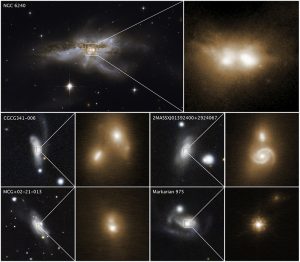Study Results Shed Light on Supermassive Black Hole Collisions

Adaptive optics help correct the blurring effect on light created by Earth’s atmosphere. W. M. Keck Observatory’s laser guide star adaptive optics (LGS AO) system uses a laser to create an artificial star to measure for atmospheric distortions. This results in sharp, high-resolution images that allow astronomers to see celestial objects, such as hidden galaxy mergers, in ultra-fine detail. PC: Billy Doaner/WM Keck Observatory.
Astronomers recently captured the best views to-date of two supermassive black holes on a collision course at the center of merging galaxies. The discovery may help scientists understand how supermassive black holes become so large.
“Seeing the pairs of merging galaxy nuclei associated with ‘huge’ black holes so close together was pretty amazing,” said lead author of the study, Michael Koss of Eureka Scientific Inc. in Kirkland, Washington. “The images are pretty powerful since they are ten times sharper than images from normal telescopes on the ground. It’s similar to going from legally blind (20/200 vision) to perfect 20/20 vision when you put on your eyeglasses. In our study, we see two galaxy nuclei right when the images were taken. You can’t argue with it; it’s a very clean result which doesn’t rely on interpretation.”
The study results appeared online Nov. 7, 2018 issue of the journal Nature.
Koss and his team of researchers made the discovery after completing the largest systematic survey of nearby galaxies using high-resolution images taken with W. M. Keck Observatory’s adaptive optics (AO) system and near-infrared camera (NIRC2), along with more than 20 years of archival Hubble Space Telescope images. With the data gleaned from this comprehensive survey, astronomers can pinpoint the types of galaxies most likely to harbor close pairs of supermassive black holes.
“This is the first large systematic survey of 500 galaxies that really isolated these hidden late stage black hole mergers that are heavily obscured and highly luminous,” said Koss. “It’s the first time this population has really been discovered. We found a surprising number of supermassive black holes growing larger and faster in the final stages of galaxy mergers.”

These images reveal the final stage of a union between pairs of galactic nuclei in the messy cores of colliding galaxies. The image at top left, taken by Hubble’s Wide Field Camera 3, shows the merging galaxy NGC 6240. A close-up of the two brilliant cores of this galactic union is shown at top right. This view, taken in infrared light, pierces the dense cloud of dust and gas encasing the two colliding galaxies and uncovers the active cores. The hefty black holes in these cores are growing quickly as they feast on gas kicked up by the galaxy merger. The black holes’ speedy growth occurs during the last 10 million to 20 million years of the merger. Images of four other colliding galaxies, along with close-up views of their coalescing nuclei in the bright cores, are shown beneath the snapshots of NGC 6240. The images of the bright cores were taken in near-infrared light by the W. M. Keck Observatory in Hawaii, using adaptive optics to sharpen the view. The reference images (left) of the merging galaxies were taken by the Panoramic Survey Telescope and Rapid Response System (Pan-STARRS). The two nuclei in the Hubble and Keck Observatory photos are only about 3,000 light-years apart — a near embrace in cosmic terms. If there are pairs of black holes, they will likely merge within the next 10 million years to form a more massive black hole. These observations are part of the largest-ever survey of the cores of nearby galaxies using high-resolution images in near-infrared light taken by the Hubble and Keck observatories. The survey galaxies’ average distance is 330 million light-years from Earth. CREDIT: NASA/ESA/M. KOSS (EUREKA SCIENTIFIC, INC.)/PAN-STARRS/W. M. KECK OBSERVATORY
Scientists theorize that every large galaxy plays host to a supermassive black hole at its center. When galaxies merge, so do their respective black holes. This process takes billions of years, but ends in seconds. At present, a supermassive black hole merger has never been directly observed.
Finding galactic nuclei so close together is difficult because the latent stages of a galaxy merger kick up a lot of gas and dust—especially in the final, most violent stages—obscuring the view. Astronomers were unable to observe this type of event until now.
“Heavily obscured galaxy nuclei don’t have a bright point source in the center like a lot of luminous unobscured supermassive black holes do,” said Koss. “But we were able to detect them thanks to X-ray data from the Burst Alert Telescope (BAT). We then used the superior laser capability of Keck Observatory’s AO system to perform high-resolution, near-infrared imaging to distinctly see a double nucleus through the gas and dust and uncover the hidden mergers.”
Koss and his team’s findings support the theory that galaxy mergers explain how some supermassive black holes become so monstrously large.
“There are competing ideas; one idea is that you have a bunch of gas in the galaxy that slowly feeds the supermassive black hole. The other is idea is that you need galaxy mergers to trigger large growth. Our data argues for the second case, that these galaxy mergers are really critical in fueling the growth of supermassive black holes,” said Koss.
The survey may also help astronomers observe for the first time a black hole merger.
Koss and his team focused on galaxies with an average distance of 330 million light-years from Earth. Many of the galaxies are similar in size to the Milky Way. The images suggest what will likely happen in roughly a billion years when our own galaxy merges with the nearby Andromeda galaxy.













